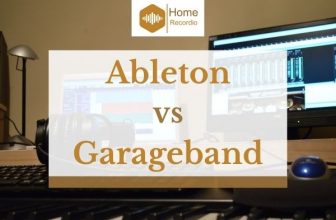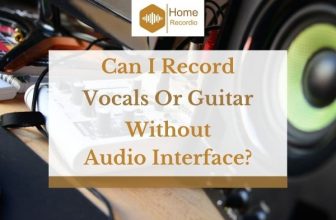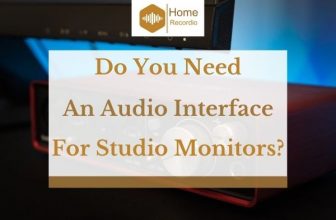Are Studio Monitors Good For Listening To Music?
Are studio monitors good for listening to music?
Yes, they are. Unlike home / commercial speakers, studio monitors have been carefully designed for professional audio production, where precision is essential.
Made to listen to music and to “sound good,” studio monitors tend to generate a very flat and wide frequency, with no added bass that simply does not distort the sound and be faithful to the original track. Their function is to sound as accurate as possible to hear what is really in the audio.
The flat, transparent response of studio monitors makes it possible to edit down to professional mixes accurately.
Studio monitors are meant to sound accurate and not just nice, so they are primarily used to monitor a recording in a studio.
If you are looking for information on studio monitors to set up something like a professional studio at home, you have come to the right place.
In this article, I will elaborate on everything you need to know to make a conscious decision before going for your next monitors.
Table of Contents
Are Studio Monitors Good For Listening To Music?
[amazon box=”B075QVMBT9″]You already know the answer, Yes, but there are a few things to consider, so let’s dive into the subject. Believing that any speaker can do the same as an audio monitor is a common misconception far from reality. Small speakers like home or office speakers handle frequencies differently.
They are designed to enjoy music without the obligation to maintain the balance between bass, midrange, and treble, which can compromise the quality of your mix or sound in case of using them in your recording studio or area set up for quality music listening.
Nowadays, some brands build home speakers with suitable components, which usually cost more but sound really good (linear and clear) just to enjoy music.
Studio Monitors – The Secret To A Good Audio Mix
If you are looking for quality sound and accuracy, then you need quality studio monitors; they are the only devices that can guarantee to reproduce the audio coming from a digital or analog source as accurately and as flat as possible, i.e., not boosting or softening any frequencies.
Studio monitors are the ones that can give you the greatest fidelity in reproduction and guarantee that what you hear is really the audio you are working with. And therein lies the secret to a good audio mix.
Keep in mind that depending on the quality of the components used by different brands determines the “flat” frequency response and the level of quality in that sense of most monitors.
That is why some audio engineers/enthusiasts and producers prefer some monitors over others due to accuracy, quality, music application, and frequency response.
Having said the above, I suggest you use studio monitors considering the following:
- The big risk: as each manufacturer has a specific goal in mind, different speakers produce different “plans” sounds so that a frequency can be softened or changed in them. You run the risk of being fooled by the sound you hear.
- Frequency bands: mixing without fidelity can be a problem. When playing sound on another device, it may soften or exaggerate some frequency bands. That way, your work will be basically in vain.
- Proper positioning: It is not enough to have a good studio monitor. To avoid conflicts or cancellation of frequencies, it is also necessary to position it appropriately.
- Cost is not decisive: as I am telling you, the price of studio monitors does not necessarily define their quality. Do not be impressed by brands; you can end up paying more money seduced by the brand or even investing in differentials inaudible to your ears.
- Comparing is key: don’t blindly trust your preferred studio monitor. Try other brand options and check the mixes on your headphones. But remember to use specific headphones for mixing, of flat sound like Beats – or similar – ever!
Home Speakers – Information
[amazon box=”B07FKH3VPV”]As I mentioned, regular home speakers are designed only for listening to and enjoying music. This is because manufacturers manage to modify the frequency response of their speakers so that they sound really good and pleasant to the ear.
But that modification in-home speakers in exchange for a “nice sound” means that:
- The sound from the speaker is not accurate, and a song may sound completely different in a car or on your headphones.
- Some speakers have a high limiting/compression built to prevent too much sound, creating a pumping effect that is not good.
Regardless, home monitors are fairly popular as they sound great and appeal to the average listener.
4 Fundamental Criteria To Correctly Choose A Studio monitor
1. The Size
The size of the room where you will place your monitors is decisive when choosing your studio monitors.
This first step is relatively proportional to the choice of your monitors. That is, in places that are too small, using large monitors is a mistake. For these cases, I suggest choosing a small monitor with 5–7-inch speakers.
On the other hand, for larger spaces like living rooms, I suggest choosing monitors with 10 – 12-inch speakers, they can be more than enough.
If you decide to use larger monitors in a moderately small room, the bass can be a hassle. This may cause you to minimize mixing bass so that you don’t feel it’s overdone.
And what would be the problem?
Your monitor, because it will make you bring out bass that you shouldn’t, just to sound good in the room. When playing sound in a balanced room or on headphones, the mix will be bass-poor. In the opposite case, from a small speaker playing in a large room, you will probably have too much bass in your final mix.
So, considering a space like a bedroom, 5–6-inch studio monitors usually work very well.
2. Total Routes
As you should know, a “path” corresponds to each element/speaker of the monitors. The most common number of routes are:
- 2-way: one element for a tweeter/treble and another for mid and bass.
- 3-way: one for the mids, one element for tweeter/treble, and one for the bass.
- 4-way: in general, two of the elements are dedicated to the mids.
You may think that the more routes, the better. That has a bit of truth. Everything will depend on the quality of the speakers and your budget when purchasing them. If you don’t have the money, I suggest buying a good two-way studio monitor over a bad three-way or more.
Aim to buy 3-way studio monitors; for me, they are the best option. Of course, choose a brand known for using suitable components. Remember, the key is good components; without them, even if the monitor has a dozen ways, the sound will not be adequate.
3. Active Or Passive Mode: Which One To Choose?
Once you choose the size and the number of routes, the third thing is the choice of the modality. The designation “passive” is related to the autonomy of studio monitors, for which the use of an amplifier is necessary.
As a result, buying a passive monitor generally costs you double. One, for the monitors themselves and the other, for the amplifier that will power it.
The “active” studio monitor, on the other hand, is the one with an integrated amplifier. Simply connect it to the digital or analog source and power output, and it is ready for use.
The amplifiers of active monitors work very well, which is why today they are the preferred choice in studios looking to make a name for themselves.
You can identify if a monitor is active or passive by checking its rear panel; the active one has a current output and the passive one does not.
As for which one to choose, some prefer the passive monitor + amplifier so as not to leave the audio uneven and give it the “colorful” they want. This depends on the financial capacity and is at the discretion of each person.
4. Power, Without Compromising Quality
This is the most technical specification factor of studio monitors. The larger it is, the louder the monitor should “talk” without compromising its quality.
However, it is vital to keep these two realities in mind:
- Power is not related to quality;
- Even if a manufacturer swears that their monitor has a specific power, distortion is possible by not reaching it.
I suggest you hear how the studio monitor works; it is essential to do a full-power test and not rely solely on instruction manuals or believe you “have experience” from videos. Take some time to visit stores, studios and read reviews.
Think of the concept of “headroom,” also known as peak headroom, which corresponds to a safety zone for mixing and mastering. The lower the ratio between them, the more difficult it will be to master. The result is likely to be clipping and distortion at the peaks.
What Other Parameters Are Important In Choosing A Good Studio Monitor?
You must take into account the following parameters to choose the one indicated:
Flat Response
That a monitor has a “flat response” means that it does not have exaggerated treble or super bass, but its sound is as faithful as possible to the track. That is, it sounds as flat and accurate as possible so that you hear what’s really in the audio in a transparent way.
Remember, this is the essential feature for accurate editing and mixing. However, not all studio monitors offer this feature, although they should.
Keep in mind that cheaper monitors often lack this response. That’s why I insist on suggesting that it’s key to investigate whether the monitor you are about to buy really does offer a flat, transparent response.
Equalizer/Controls
A studio monitor needs to have equalization controls. It is one of the essential features that characterize and generally have good quality studio monitors like the one you are looking for.
Why is it essential to have a built-in EQ?
- This function allows you to compensate for sound disproportions generally generated in studio environments, where it is necessary to equalize the sound.
- In other words, the acoustics of some venues can emphasize the depth of the bass, and with the equalizer, you can lower the bass for a flatter response.
Conclusion
Are studio monitors good for listening to music?
Yes, they are excellent. However, you have to consider all the things that I have described in this article if your sole purpose is simply to listen to music.
Although they sound great, if you are only going to use the studio monitors for listening, that can be a somewhat expensive indulgence in that use case.
I suggest getting studio monitors if you know you will do other things with them (like producing, mixing, mastering, etc.) rather than just getting them specifically for listening.
Also, if you get them just for listening, keep in mind that you’ll need to be located within the stereo field of the speakers to get an excellent stereo picture.
Keep in mind that regular home speakers are designed to enjoy pleasant sound anywhere. The manufacturers know this, and that is why they have designed it that specific way.
Although you can sit anywhere on your property and listen to good music on a stereo speaker, you will probably get a sound that is not as accurate as you expect.
It is because the frequency of these monitors is intended to sound as pleasing to the ear of the audience as possible and not as you are used to.




